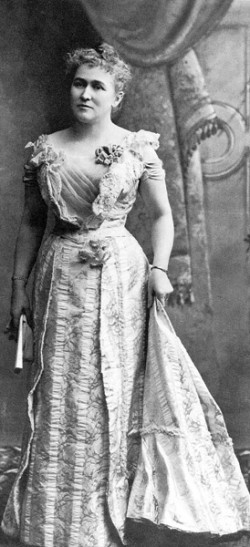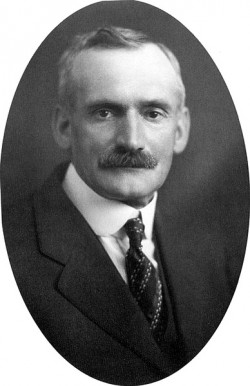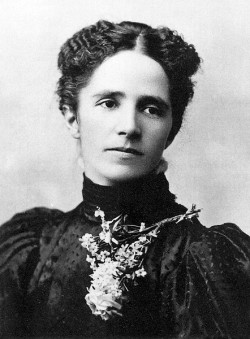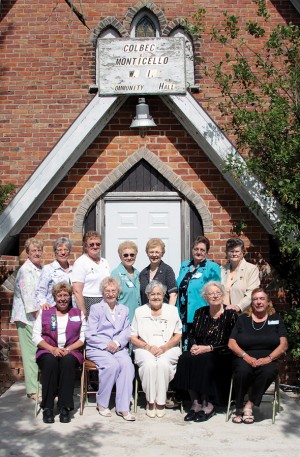Women’s Institute: For Home and Country
The Women’s Institute has been called the most effective women’s organization ever – with good reason. For over a century, the WI has been welcoming, educating, challenging, improving, supporting and “getting things done.”

Adelaide Hoodless founded the Women’s Institutes in 1897, after her baby died from drinking impure milk. She was also a key player in establishing the National Council of Women and the Victorian Order of Nurses.
For a visitor to the 100th anniversary celebration of the Colbeck & Monticello Women’s Institute this past summer, a few impressions were immediate. First, the women gathered at the historic WI Hall in Colbeck were all seniors, some of them well along in that category. Second, their age was not remotely interfering with their ability to have a really good time.
Ten different WI branches from around the hills were represented at the celebration and it was clear that spirited humour, music, great food and genuine enjoyment of the company of others all took place with the easy familiarity of years of fellowship.
Another impression was just as enlightening. During the official ceremony, Pearl Newson, emcee for the host branch, accepted a commemorative plaque from the mayor of East Luther Grand Valley. Mayor Oosterhof made a gracious presentation and Pearl’s appreciation was equally gracious. Then, before the mayor had a chance to sit down, Pearl asked, “Now, how soon are you going to have it put up?”
The plaque was installed before the month was out – proof again that the Women’s Institute knows how to get things done.
From painted lines to pants pockets
The list of the Women’s Institutes’ achievements since their beginnings in 1897 is awe-inspiring. Even so, WI members seem strangely reluctant to toot their own horns, and many of their accomplishments go unsung. As a once prominent Ontario politician put it: “These women can nail down a project as well as any Rotary or Lions club. They just make less noise doing it!” (The politician insisted on anonymity, understandable given that he is a former Rotarian – and a Lion.)
“Jan.1933. Held a Euchre, proceeds $21.90 cents. Flannelette bought and diapers made for one family. Layette given to another. Paid one-fourth of expense of innoculating the children.”
– excerpts from the minutes of the Salem WI in the thirties and forties
Noise or not, our world would be a lesser place were it not for the efforts of the WI, both in grand schemes and tiny details. In Ontario, for example, the influence of the FWIO (Federation of Women’s Institutes of Ontario) was crucial in establishing such provincial laws as mandatory stopping when school bus lights are flashing, clear markings on poison containers, easy-to-understand food labels, the proper use of slow-moving vehicle signs – and in an earlier day, the installation of railway crossing signs and lane lines on provincial highways.
In addition to consumer advocacy and public safety, the WI has also made important contributions to larger social issues. As early as 1951, long before the formation of the Equal Pay Coalition and fully thirty-six years before the Ontario government passed the Pay Equity Act, the WI was lobbying for equal pay for equal work. More recently, with the equal pay objective pretty much in hand, the WI has tackled another inequality: the fact that grandparents who legally assume the rearing of grandchildren are funded at a lower rate than unrelated foster parents.
“May 2nd, 1934. There were 18 members. Program: Lullaby song by little Ruth Moffat. Little Miss Marjorie French and Master Jim Woodland gave short dialogue. In a nail driving contest Harry French won the prize.”
If it is, as their motto says, “for home and country,” there is no issue too big and no detail too small for the attention of the WI. An example of the latter: In the mid-fifties, the Institutes tackled the Canadian Manufacturers Association on the inferior workmanship, design and material of the pockets in men’s trousers. Although the effect of their lobbying cannot be proven, anyone old enough to remember pant pockets of that era would agree the quality has greatly improved. While they were at it, the WI also successfully took on the CMA over flammability of sleepwear and proper identification of shoe sizes.
And the work goes on. A current WI advocacy project is the strengthening and enforcement of made-in-Canada labelling, an undertaking aimed at edifying Canadian consumers, as well as benefitting Canadian producers.
First Ontario, then the world

Though Erland Lee is less known than Adelaide Hoodless, he is credited as a co-founder of the WI for his important support in organizing the fi rst branch with her in Stoney Creek.
The story that Adelaide Hoodless founded the Women’s Institutes because her baby died from drinking impure milk has become legend. Adelaide was indeed a dynamo – she was also a key player in establishing the National Council of Women and the Victorian Order of Nurses. However, in addition to Adelaide, there was an important male figure involved in the founding of the WI.
In 1896, Erland Lee, a member of the influential Farmers’ Institutes and a forward thinker like Adelaide, had watched her turn an annual conference on its ear. The audience, almost entirely male farmers and less than pleased about listening to a woman speaker, was shocked to hear her point out, correctly it seems, that they fed their pigs and cattle more scientifically than their own families.
“May 5th, 1938. There were 20 members. All members were to provide own lunch. November, euchre postponed because of scarlet fever. Demonstration on meat cookery.”
Adelaide’s address inspired Erland Lee to bring her to speak in Stoney Creek. With his help, that event led to the establishment of the world’s first Women’s Institute branch in 1897. Although Adelaide’s compelling story is more famous, the FWIO regards Hoodless and Lee as co-founders.
After 1897, Canada-wide and then worldwide interest in the ideals of the Women’s Institutes accelerated rapidly. In 1919, the many branches that had been established in Ontario united to form the FWIO. In the same year, Ontario’s federation joined with groups in other provinces to form the Federated Women’s Institutes of Canada. In 1933, an international group, the Associated Country Women of the World was created, an affiliation that today includes seventy countries.
Within ten years of the Stoney Creek founding, nineteen WI branches had been established throughout our hills. By the end of World War I, there were thirty-three. By the fiftieth anniversary of the WI there were fifty-seven. (On that occasion, FWIO planned for 6,000 attendees at an official ceremony in Guelph; 12,000 showed up.) At one time, there were even local Junior WIs, in Bolton and Hillsburgh, among others.
Although the Colbeck & Monticello centennial celebration was impressive, two other branches, in Camilla and Horning’s Mills, had already passed that auspicious anniversary, each claiming 107 years of continuous operation. Even the youngest among the active local branches, Hockley Valley, has a sixty year history.
Still on top of things
Now well into its second century, the FWIO has become a much smaller organization, but there has been no let-up in the commitment to home and country. Along with its traditional causes, especially education, the organization has also embraced more contemporary concerns. They include participation in the Support Our Soldiers Programme, launched when Canadian troops entered Afghanistan, and fundraising for such programs as Women Feed the World and Water for All.
In Ontario especially, the WI continues its long-time support of 4-H clubs, and more recently the ROSE initiative (rural Ontario sharing education) has brought attention to the organization’s education and support programs and to its efforts to enhance personal growth and empowerment for women.
However, those broader objectives and global interests have never diverted branches from their profound sense of local commitment and from their long-established practice of making modest, but meaningful contributions to community betterment.
“May 1939. There were 17 members. Several charitable donations. A motion made to send direct to Dufferin boys overseas, rather than through the Red Cross.”

Alice Hollingsworth, a travelling lecturer with the Department of Agriculture, organized 18 new WI branches before retiring to Creemore in 1902. Like Adelaide Hoodless, she encountered heavy opposition from men, like the farmer who told her, “Don’t bring the Women’s Institute here or we won’t be able to get a woman to milk a cow!”
In Violet Hill, the branch has a long tradition of support for the children’s literature collection at the Shelburne Public Library. And recently, the Horning’s Mills Branch brought in an expert on telephone solicitation fraud to speak to seniors. Every branch in this region also contributes an annual scholarship to a local school. The Camilla Branch, for example, supports history and French at Mono-Amaranth school and The Maples branch provides a science award to East Garafraxa school.
“May 5th, 1943. Entertained Orangeville and Blount Institutes. Filled 10 ditty bags. Canvas for Children’s Aid Society. Boxes packed for boys overseas.”
Membership issues in a changing world
Still, in spite of its impressive history, the grim reality for the Women’s Institutes is that membership has been shrinking dramatically for some time. Not that this issue is unique to the WI; it is true internationally for almost every traditional community organization, especially it seems, the historic associations developed primarily by and for women.
According to the Encyclopedia of Associations, membership in the Business and Professional Women’s Association is down about 90 per cent from its peak; the Order of the Eastern Star is down 75 per cent, and in the U.S., the Association of University Women is off by 84 per cent. Even the PTA has declined by 60 per cent.
By comparison, Rotary, now co-gendered, is down 25 per cent, the Masons 71 per cent and the Lions 58 per cent. (Note these are international, primarily U.S. numbers. Canadian membership data is more difficult to confirm.)

Members and Guests of the Colbeck & Monticello WI Centennial 2009 back row, from left to right : Audrey Bruce; Joy Trimble, The Maples Branch & President of the FWIO; Laura Edwards; June Mournahan-Watson; Pearl White- Newson, President, Colbeck & Monticello Women’s Institute; Alice Mournahan; Edith Reilly. front row, from left to right : Vi Belrose, Hockley Valley Branch & Chair of the Central Ontario Area Women’s Institutes; Ada Brayford; Ivadelle Bruce; Catrina Bouwhuis; Maureen Parker, Salem Branch and President, Dufferin- Peel District Women’s Institute. absent : Ruth McPherson. Photo by Kate Martin.
The current president of FWIO, Joy Trimble, a resident of Amaranth and member of The Maples branch, offered this sober analysis at the Colbeck & Monticello Institute anniversary: “Ontario membership is about a fifth of what it was in the early 1960s. One of our frustrations is that although we are definitely getting new members – we just opened a new branch in Guelph recently and one in Picton – retirement is outpacing recruitment.”
Seven members of the host branch were present that day at the Colbeck hall. Collectively they had been members of the WI for 382 years, an average of well over fifty years each. As powerful a statement of service to home and country as those numbers are, they also reinforced Joy Trimble’s point.
“January, 1944. Petition to have a more obliging and understanding person at head of ration office.”
At its founding, the Women’s Institute was established primarily as an organization for rural women, but the demographic shift from rural to urban was already underway. By 1921, 50 per cent of Ontario’s population was classified as urban. Although the WI broadened its appeal a long time ago in order to attract urban women, Joy Trimble says there is a more profound social dynamic influencing WI membership, namely that so many women are now employed outside the home, while still retaining the lion’s share of responsibility for homemaking and child-rearing – with the result that time for community service is often lost in the squeeze.
“May 1946. There were 13 members. Distributed cards for T.B.Clinic. Donated $10.00 to Cancer Fund. There was a donation of $50 to Miss Shaw for the incubator.”
Time for a rethink?
Ironically, the WI could offer one of the very cures for the frenetic busyness that has discouraged new membership. Among the most important characteristics of WI meetings are the comfort, relief from stress, and welcoming attitude that is central to everything they do.
“The meetings, the friendship, all the laughing, it just makes you feel good,” says one local member. “My kids were teenagers when I joined. I was working full time and to be honest I didn’t really think I would stick with it, but somehow, I don’t know, WI makes me feel better. Like there is something more to life.”
Joy Trimble realizes that one of the keys to renewal is raising awareness of just that kind of experience. “We have strategies we’re working on in FWIO,” she explains. “There’s an open door for current 4-H members and young people in general, and we believe there’s a whole new target group out there now: women who were too busy with family and careers earlier in their lives but are now retiring. They aren’t the type to just sit around and we think the stimulation and social networking in WI has a lot to offer them.
“What’s important is for the Institutes to get the word out so that potential members can discover just how personally fulfilling their participation can be, and how much fun they can have in the process.”
More Info
Just getting things done
Although the WI is noted for mighty and far-reaching accomplishments – a branch of the WI, for example, was instrumental in the founding of Brock University; and during both world wars, the massive efforts of the WI in Canada had international repercussions – over the years it is the work in local communities that makes this organization shine.
Occasionally, these local efforts have been very specialized, as in the case of the Marsville WI which, according to local media, actually raised an orphan child in the 1920s. At other times branches would band together on a here-at-home project like the County Children’s Shelter in Orangeville. During the 1930s and ’40s the shelter benefitted from quilts, furniture, cash, and food donations, not only from the Orangeville branch, but from branches in Honeywood, Waldemar, Bowling Green and others. Today, branches in Dufferin support Family Transition Place, Headwaters Hospital and Hospice Dufferin. Camilla members, for example, produce a quilt a year on average, which becomes a valued lottery prize for fundraising.
In Peel, when visitors flooded into the International Plowing Match at Caledon Village in 1963, branches from Mono Road, Alton, Inglewood, Sandhill and Belfountain joined with others in the county to serve over 7,000 hot meals. It was a peace-time effort not unlike the collective effort that had gone into such FWIO-led projects as Seeds for English Gardens in World War II. Between 1941 and 1945 this hugely successful program sent over two tons of tiny garden seeds to Great Britain, with branches in places like Creemore, Bolton, and Waldemar specifically commended for their contributions.
Other examples of community leadership include the efforts of the Mono Road WI to preserve the pioneer Caesar’s Cemetery in former Chinguacousy Township. And the Colbeck & Monticello Women’s Institute Community Hall became just that, a community hall, when the branch took on the challenge of saving a former church built in 1884. With their creative fundraising and hours of volunteer labour, including the addition of a basement, a corner of East Luther gained an ideal meeting place.
To the southeast, The Maples WI turned yet another former church into a community hall, this time with an unusual twist: the branch assumed ownership way back in 1919 and over the years turned it into a very modern accommodation. Then, in 1976, it had to incorporate to retain title. Hence we have The Maples Women’s Institute Inc., making our hills the host of a genuine rarity in a worldwide volunteer organization.
Tweedsmuir histories
For an association of women devoted to their communities, an interest in local history comes naturally. As early as 1925 the FWIO had a standing committee devoted to historical research. It was in anticipation of the fiftieth anniversary, however, that one of the better-known projects of the WI, the Tweedsmuir Histories, was officially launched in 1945.
The recently widowed Lady Tweedsmuir was happy to approve the use of the former governor-general’s name, and this no doubt helped encourage the branches throughout Ontario to develop histories of their local area. Within ten years, the FWIO reported that 989 branches were compiling histories.
With the possible exception of the Perkins Bull histories of Peel and area, this undertaking by the WI was a Canadian one-of-a-kind. Until then, local history was simply not on the radar.
What resulted from the effort is, quite simply, a gold mine. The histories vary in production quality from simple scrapbooks to leather-bound volumes, but notwithstanding such differences, the “Tweedsmuirs” literally rescued vital information on the early settlers, family histories, farming practices, commerce and industry, municipal governance, and the church and school activities that shaped our communities.
Sometimes the histories include what appear to be idiosyncratic undertakings by individual members. The Tweedsmuir of the former Coleridge Union Branch, for instance, contains not only the standard fare, but a detailed and exceptionally well-written (and hand-written) account of how roads were developed and maintained in early Amaranth Township.
The Tweedsmuirs have received awards from the Canadian Historical Association, the American Association for Local History, and the Scadding Award of Excellence from the Ontario Historical Society.
Many of the histories are now available to the public in local museums and archives. The Peel Heritage Complex is the official repository for all the Tweedsmuirs of the region. (A fine example in the collection is a four-volume compilation by the former Rosehill WI.) In Wellington, the collection is now available online. The archives in Dufferin hold some but not all of the Tweedsmuirs in that county and anticipate acquiring more.







Most inspiring when we are considering restructuting.
Ruth Anne Robinson from Huron-Kinloss, On on Oct 7, 2015 at 5:13 pm |
A really excellent article, thanks so much, WI member.
CynthiaRabstein from Belwood Ontario on Aug 26, 2015 at 7:05 pm |
Great article! Thank you for the information.
Ellen Waye from Point Clark , ON on Aug 18, 2015 at 2:44 pm |
What a great story, thanks for blowing their horn, there is still work to be done in our country and the world, and W.I. is just the group to get at it!!
Joan holthe from bonanza, ab on Aug 18, 2015 at 10:18 am |